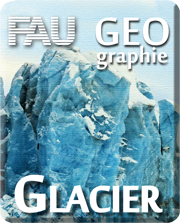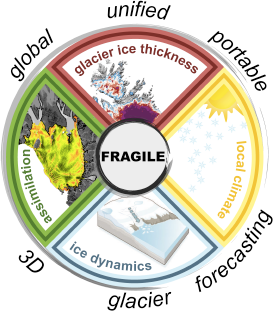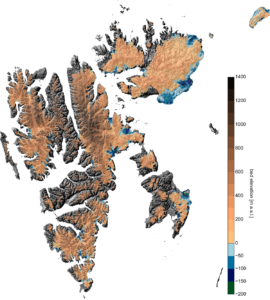Glacier Systems & Natural Hazards
 Worldwide glacier retreat is increasingly tangible and the associated ice-loss has dominated the cryospheric contribution to sea-level change for many decades. Therefore, the interest of the Glacier Systems & Natural Hazards Group is to understand and describe processes that control glacier evolution in the past and future. The anticipated glacier retreat calls for an appropriate assessment of glacier-related risks such as seasonal water availability, flank instabilities and glacial lake outburst floods. Adequate modelling strategies therefore require a holistic view on the whole glacier system including hydrologic, geomorphologic and atmospheric processes. We consider processes such as iceberg calving, meltwater routing beneath glaciers, debris flows as well as insulation of permafrost.
Worldwide glacier retreat is increasingly tangible and the associated ice-loss has dominated the cryospheric contribution to sea-level change for many decades. Therefore, the interest of the Glacier Systems & Natural Hazards Group is to understand and describe processes that control glacier evolution in the past and future. The anticipated glacier retreat calls for an appropriate assessment of glacier-related risks such as seasonal water availability, flank instabilities and glacial lake outburst floods. Adequate modelling strategies therefore require a holistic view on the whole glacier system including hydrologic, geomorphologic and atmospheric processes. We consider processes such as iceberg calving, meltwater routing beneath glaciers, debris flows as well as insulation of permafrost.
The group further pursues the vision of a systematic utilisation of the rapidly growing body of information from satellite remote sensing to maximise the information flow into geophysical models. In this way, we hope to better constrain unknown parameters such as basal friction, calving or the basal topography. Ultimately the purpose is to increase the confidence in transient simulations of glacier evolution for the past and future. Applications reach from single glaciers to regional studies as well as to ice-sheet wide scales.
In short, we are ice-loving scientists and we consider ourselves supportive and friendly people.
Group members
Veena Prasad
- Email: veena.prasad@fau.de
Research foci
Topics
- Ice-dynamic evolution of glaciers and ice sheets
- Glacier projections under climatic changes
- Climate change and sea-level rise
- Glacier-related hazards in high-mountain areas
Methods
- Systematic data assimilation
- Numeric forecasting frameworks
- Big data
Projects
FRAGILE
FRAGILE – Next generation framework for global glacier forecasting
Worldwide glacier retreat outside the two large ice sheets is increasingly tangible and the associated ice-loss has dominated the cryospheric contribution to sea-level change for many decades.  This retreat has also become symbolic for the effects of the generally warming climate. Despite the anticipated importance for future sea-level rise, continuing glacier retreat will affect seasonal freshwater availability and might add to regional water-stress in this century. Here, I envision a novel self-consistent, ice-dynamic forecasting framework for global glacier evolution that will lift the confidence in forward projections for this century to new heights. For the first time, each glacier on Earth will be treated as a three-dimension body within its surrounding topography without using any form of geometric simplification. The heart of the framework is the systematic utilisation of the rapidly growing body of information from satellite remote sensing. For this purpose, I intend to pass on to ensemble assimilation techniques that transiently consider measurements as they become available. This will streamline and increase the total information flow into glacier models. In terms of climatic forcing, global products will be replaced by regional forecasts with high-resolution climate models. Moreover, a more realistic representation of the local energy balance at the glacier surface is pursued that ensures multi-decadal stability in the melt formulation. The envisaged 3D finite-element modelling framework also allows a direct integration of iceberg calving, which is, on global scales, an oftenunconsidered dynamic ice-loss term. To this day, a key limitation of glacier projections is the poorly constrained ice volume and its distribution at present. Here, I put forward a promising remedy that builds on multi-temporal satellite information to calibrate a state-of-the-art reconstruction approach for mapping basinwide ice thickness on virtually any glacier.
This retreat has also become symbolic for the effects of the generally warming climate. Despite the anticipated importance for future sea-level rise, continuing glacier retreat will affect seasonal freshwater availability and might add to regional water-stress in this century. Here, I envision a novel self-consistent, ice-dynamic forecasting framework for global glacier evolution that will lift the confidence in forward projections for this century to new heights. For the first time, each glacier on Earth will be treated as a three-dimension body within its surrounding topography without using any form of geometric simplification. The heart of the framework is the systematic utilisation of the rapidly growing body of information from satellite remote sensing. For this purpose, I intend to pass on to ensemble assimilation techniques that transiently consider measurements as they become available. This will streamline and increase the total information flow into glacier models. In terms of climatic forcing, global products will be replaced by regional forecasts with high-resolution climate models. Moreover, a more realistic representation of the local energy balance at the glacier surface is pursued that ensures multi-decadal stability in the melt formulation. The envisaged 3D finite-element modelling framework also allows a direct integration of iceberg calving, which is, on global scales, an oftenunconsidered dynamic ice-loss term. To this day, a key limitation of glacier projections is the poorly constrained ice volume and its distribution at present. Here, I put forward a promising remedy that builds on multi-temporal satellite information to calibrate a state-of-the-art reconstruction approach for mapping basinwide ice thickness on virtually any glacier.
European Research Council (ERC) – Starting Grant
Period: 2021 – 2026
Project staff: Theresa Diener, Alexander R. Groos, Johannes Fürst
MAGIC
MAGIC – The Mountain Glacier Forecast Framework
General glacier retreat around the globe has become iconic to illustrate the effects of global warming and we anticipate that this demise will continue and significantly add to global sea-level rise. Ice loss can also induce shifts in regional water resources, putting some places at high risk of year-around freshwater availability. Better projections of glacier retreat are therefore essential in terms of coastal impact, water management and hydro-glaciological risks. The overall aim of the project is to provide a framework to improve past and future glacier volume projections. The process-based framework will be based on the open-source ice-flow model Elmer/Ice and will allow to reduce three potentially important sources of uncertainty. Anticipating the continuously growing body of information from satellite remote sensing, we will improve and develop robust data assimilation methods to infer the basal topography beneath the ice and calibrate ice-flow parameters for a better representation of the initial state and ice dynamics. The flow model will be coupled to an enhanced surface mass balance model that exhibits a stable melt relation over relevant multi-decadal timescales. Based on ensemble simulations, the framework will allow to better quantify the interaction and propagation of these uncertainties. As a proof of concept, the framework will be applied to hindcast and forecast glacier evolutions in the French Alps and in Cordillera Darwin (Chile). These sites have been chosen because for both glacier sites ice-flow is considered important and because of the availability of in-situ and remotely sensed observations. The two sites will further serve as challenging test setups to scrutinise the applicability, performance and robustness of the modelling framework under different climatic conditions and dynamic settings.
Deutsche Forschungsgemeinschaft (DFG) – Project ID: 431767937![]()
Period: 2020-2023
Project staff: Franziska Temme, Johannes Fürst, Fabien Gillet-Chaulet
TAPE
Tapping the potential of Earth Observations (TAPE) – FAU Emerging Fields Initiative
Project staff: Thorsten Seehaus, Lukas Sochor, Matthias Braun, Johannes Fürst, Eberhard Bänsch, Andreas Maier, Nora Gourmelon
The aim of this project is to analyse the time series of Earth observation (EO) data with innovative ‘deep learning’ methods in order to develop efficient algorithms for dealing with the large amounts of data involved. The value of these EO products is further increased by advanced interpolation techniques and assimilation in geophysical models from applied mathematics.
Funding period 2019-2022
Completed projects
SVALbard-Bedrock
Global surface temperatures have risen by ~0.7°C over the previous century. Due to an inherent amplification of climatic changes in high latitudes, warming has been more expressed in Polar Regions. One eminent consequence is the general retreat of Svalbard glaciers observed throughout the last century. In the last decades, southern Svalbard glaciers have even moved on to thin at dramatically increasing rates. This latest thinning trend is however not confirmed throughout the Arctic. The reason relies in the unique climatic conditions on Svalbard.  Since warm ocean currents in the North Atlantic reach the southern tip of the archipelago, the climate is rather warm and variable for its latitudinal band. Evolution of Svalbard glaciers has therefore often been suggested to play a precursor role for the other Arctic regions.Within the Arctic, Svalbard is unique in another respect, as glacier extents and elevation changes are well characterised over several decades. However, the interpretation of these geometric changes in terms of the climatic evolution is inhibited, as they arise from both the climatic surface mass balance and from ice flow divergence. The latter depends on glacier geometry and dynamics, and is not necessarily directly controlled by changes in climatological parameters. Yet, observations on glacier thicknesses and velocities are sparse and temporally incoherent, which impedes to this day a reliable quantification of the dynamic control on Svalbard glacier changes. By extension, we have only a vague idea on how much volume is annually discharged by iceberg calving at the marine ice fronts. Ice discharge presumably explains a large portion in the total mass budget, as more than half of the ice-covered area drains through marine-terminated glaciers.The aim of the research proposal is to expand the knowledge on the ice dynamic component of glacier evolution to the entire Svalbard archipelago. To this end, surface velocities are inferred from satellite remote sensing, which, in turn, serve to reconstruct the bedrock topography beneath all ice-covered areas. The reconstruction makes use of the mass conservation principle, provides therefore a flow-consistent thickness map and is already implemented in our ice flow model. Information on both ice velocities and ice thickness are a prerequisite to quantify the ice flow divergence that explains a, to this day, largely unknown portion of glacier changes. The reconstruction will therefore make it possible to better interpret recent geometric changes in the light of the observed atmospheric warming in the Arctic. Moreover, previous extrapolations for archipelago-wide estimates of ice volume and discharge can be improved on a physical basis. As the bedrock reconstruction is consistent with the observed ice flow, the map will facilitate the application of ice flow models on Svalbard. With our flow model, we aim at inferring the contribution of basal sliding to present glacier flow.
Since warm ocean currents in the North Atlantic reach the southern tip of the archipelago, the climate is rather warm and variable for its latitudinal band. Evolution of Svalbard glaciers has therefore often been suggested to play a precursor role for the other Arctic regions.Within the Arctic, Svalbard is unique in another respect, as glacier extents and elevation changes are well characterised over several decades. However, the interpretation of these geometric changes in terms of the climatic evolution is inhibited, as they arise from both the climatic surface mass balance and from ice flow divergence. The latter depends on glacier geometry and dynamics, and is not necessarily directly controlled by changes in climatological parameters. Yet, observations on glacier thicknesses and velocities are sparse and temporally incoherent, which impedes to this day a reliable quantification of the dynamic control on Svalbard glacier changes. By extension, we have only a vague idea on how much volume is annually discharged by iceberg calving at the marine ice fronts. Ice discharge presumably explains a large portion in the total mass budget, as more than half of the ice-covered area drains through marine-terminated glaciers.The aim of the research proposal is to expand the knowledge on the ice dynamic component of glacier evolution to the entire Svalbard archipelago. To this end, surface velocities are inferred from satellite remote sensing, which, in turn, serve to reconstruct the bedrock topography beneath all ice-covered areas. The reconstruction makes use of the mass conservation principle, provides therefore a flow-consistent thickness map and is already implemented in our ice flow model. Information on both ice velocities and ice thickness are a prerequisite to quantify the ice flow divergence that explains a, to this day, largely unknown portion of glacier changes. The reconstruction will therefore make it possible to better interpret recent geometric changes in the light of the observed atmospheric warming in the Arctic. Moreover, previous extrapolations for archipelago-wide estimates of ice volume and discharge can be improved on a physical basis. As the bedrock reconstruction is consistent with the observed ice flow, the map will facilitate the application of ice flow models on Svalbard. With our flow model, we aim at inferring the contribution of basal sliding to present glacier flow.
Deutsche Forschungsgemeinschaft (DFG) – Projektnummer 274939856![]()
Suggestions for bachelor and master thesis
BACHELOR
- Assess the risk for outburst floods from El Morado Glacier (J. Fürst)
- Implementing tipping cascades following ‘Wunder et al.’ (J. Fürst)
- Literature overview of glacier changes in the Cordillera Darwin (F. Temme & J. Fürst)
- Thermische Charakterisierung und Entwicklung von Alpinen Gletschern – Alpen oder Svalbard (Literaturrecherche, J. Fürst)
- Literature overview of supraglacial lakes drainages in Greenland (I. Tabone)
MASTER
- Past-to-future evolution of Langenferner, South Tyrol (J. Fürst)
- Implementation of a surge model (Benn et al., 2019) for a benchmark glacier (J. Fürst)
- Assessing the impact of föhn events on the glacier surface mass balance in Southern Patagonia, 2D modelling WRF/COSIPY (F. Temme, J. Fürst, T. Mölg)
- Time inversion in Glacier Modelling (J. Fürst)
- DIVA/ThicknessSolver (possibly KONWHIR) (J. Fürst)
- Svalbard reconstruction of glacier ice thickness – update (J. Fürst)
- Mapping debris thickness on alpine glaciers using drone-based thermography and geodesy (A. Groos)
- Understanding the impact of rocky debris on the melting and future evolution of glaciers in the central Andes, Chile (D. Farías & A. Groos / Hertha un Helmut Schmauser-Stiftung)
- Combining drone-based mapping and numerical glacier modelling to evaluate the impact of moulins and runoff on ice dynamics at the Kanderfirn glacier, Swiss Alps (I. Tabone & A. Gross)
- Thermische Isolationswirkung von Gletschern auf Permafrost im Hochgebirge (J. Fürst)
- Modelling the effect of basal hydrology on glacier dynamics at the Schiaparelli Glacier (Cordillera Darwin, Chile) (I. Tabone & F. Temme)
- Modelling the effect of supraglacial debris on the surface mass balance of alpine glaciers (A. Groos)
Job offers
Group publications
2024
- Fürst, J., Farías Barahona, D., Blindow, N., Casassa, G., Gacitúa, G., Koppes, M.,... Schaefer, M. (2024). The foundations of the Patagonian icefields. Communications Earth & Environment, 5(1). https://doi.org/10.1038/s43247-023-01193-7
- Langhamer, L., Sauter, T., Temme, F., Werner, N., Heinze, F., Arigony-Neto, J.,... Schneider, C. (2024). Response of lacustrine glacier dynamics to atmospheric forcing in the cordillera darwin. Journal of Glaciology. https://doi.org/10.1017/jog.2024.14
- Messmer, J., & Groos, A.R. (2024). A low-cost and open-source approach for supraglacial debris thickness mapping using UAV-based infrared thermography. Cryosphere, 18, 719–746. https://dx.doi.org/10.5194/tc-18-719-2024
2023
- Cook, S., Gillet-Chaulet, F., & Fürst, J. (2023). Robust reconstruction of glacier beds using transient 2D assimilation with Stokes. Journal of Glaciology. https://doi.org/10.1017/jog.2023.26
- Herrmann, O., Gourmelon, N., Seehaus, T., Maier, A., Fürst, J., Braun, M., & Christlein, V. (2023). Out-of-the-box Calving Front Detection Method Using Deep Learning. Cryosphere, 17, 4957–4977. https://doi.org/10.5194/tc-17-4957-2023
- Hofmann, F.M., Groos, A.R., Garcia Morabito, E., Struck, J., Gnägi, C., Scharf, A.,... Zech, R. (2023). A regional assessment of the deglaciation history of the Swiss Plateau based on newly obtained and re-evaluated Be-10 cosmic-ray exposure ages. Quaternary Science Advances, 13, 1-17. https://dx.doi.org/10.1016/j.qsa.2023.100124
- Koch, M., Seehaus, T., Friedl, P., & Braun, M. (2023). Automated Detection of Glacier Surges from Sentinel-1 Surface Velocity Time Series-An Example from Svalbard. Remote Sensing, 15(6). https://doi.org/10.3390/rs15061545
- Shahateet, K., Navarro, F., Seehaus, T., Fürst, J., & Braun, M. (2023). Estimating ice discharge of the Antarctic Peninsula using different ice-thickness datasets. Annals of Glaciology, 1-12. https://doi.org/10.1017/aog.2023.67
- Temme, F., Farías Barahona, D., Seehaus, T., Janã, R., Arigony-Neto, J., Gonzalez, I.,... Fürst, J. (2023). Strategies for regional modeling of surface mass balance at the Monte Sarmiento Massif, Tierra del Fuego. Cryosphere, 17(6), 2343--2365. https://doi.org/10.5194/tc-17-2343-2023
2022
- Groos, A.R., Aeschbacher, R., Fischer, M., Kohler, N., Mayer, C., & Senn-Rist, A. (2022). Accuracy of UAV Photogrammetry in Glacial and Periglacial Alpine Terrain: A Comparison With Airborne and Terrestrial Datasets. Frontiers in Remote Sensing, 3, 1-16. https://dx.doi.org/10.3389/frsen.2022.871994
- Groos, A.R., Niederhauser, J., Lemma, B., Fekadu, M., Zech, W., Haensel, F.,... Veit, H. (2022). An hourly ground temperature dataset for 16 high-elevation sites (3493–4377 m a.s.l.) in the Bale Mountains, Ethiopia (2017–2020). Earth System Science Data, 14, 1043-1062. https://dx.doi.org/10.5194/essd-14-1043-2022
2021
- Diener, T., Sasgen, I., Agosta, C., Fürst, J., Braun, M., Konrad, H., & Fettweis, X. (2021). Acceleration of Dynamic Ice Loss in Antarctica From Satellite Gravimetry. Frontiers in Earth Science, 9. https://doi.org/10.3389/feart.2021.741789
- Farinotti, D., Brinkerhoff, D.J., Fürst, J., Gantayat, P., Gillet-Chaulet, F., Huss, M.,... Andreassen, L.M. (2021). Results from the Ice Thickness Models Intercomparison eXperiment Phase 2 (ITMIX2). Frontiers in Earth Science, 8. https://doi.org/10.3389/feart.2020.571923
- Groos, A.R., Akçar, N., Yesilyurt, S., Miehe, G., Vockenhuber, C., & Veit, H. (2021). Nonuniform late pleistocene glacier fluctuations in tropical Eastern Africa. Science Advances, 7(11). https://dx.doi.org/10.1126/SCIADV.ABB6826
- Groos, A.R., Niederhauser, J., Wraase, L., Haensel, F., Nauss, T., Akçar, N., & Veit, H. (2021). The enigma of relict large sorted stone stripes in the tropical Ethiopian Highlands. Earth Surface Dynamics, 9(2), 145-166. https://dx.doi.org/10.5194/esurf-9-145-2021
- Van Tricht, L., Huybrechts, P., Van Breedam, J., Fürst, J., Rybak, O., Satylkanov, R.,... Malz, P. (2021). Measuring and inferring the ice thickness distribution of four glaciers in the Tien Shan, Kyrgyzstan. Journal of Glaciology, 67(262), 269-286. https://doi.org/10.1017/jog.2020.104
2020
- Lippl, S., Blindow, N., Fürst, J., Marinsek, S., Seehaus, T., & Braun, M. (2020). Uncertainty Assessment of Ice Discharge Using GPR-Derived Ice Thickness from Gourdon Glacier, Antarctic Peninsula. Geosciences, 10, 12. https://doi.org/10.3390/geosciences10010012
- Stadelmann, C., Fürst, J., Mölg, T., & Braun, M. (2020). Brief communication: Glacier thickness reconstruction on Mt. Kilimanjaro. Cryosphere, 14(10), 3399-3406. https://doi.org/10.5194/tc-14-3399-2020
- Temme, F., Turton, J., Mölg, T., & Sauter, T. (2020). Flow Regimes and Föhn Types Characterize the Local Climate of Southern Patagonia. Atmosphere, 11(9), 899. https://doi.org/10.3390/atmos11090899
- Welty, E., Zemp, M., Navarro, F., Huss, M., Fürst, J., Gärtner-Roer, I.,... Li, H. (2020). Worldwide version-controlled database of glacier thickness observations. Earth System Science Data, 12(4), 3039-3055. https://doi.org/10.5194/essd-12-3039-2020
2019
- Benn, D.I., Jones, R.L., Luckman, A., Fürst, J., Hewitt, I., & Sommer, C. (2019). Mass and enthalpy budget evolution during the surge of a polythermal glacier: A test of theory. Journal of Glaciology. https://doi.org/10.1017/jog.2019.63
- Farinotti, D., Huss, M., Fürst, J., Landmann, J., Machguth, H., Maussion, F., & Pandit, A. (2019). A consensus estimate for the ice thickness distribution of all glaciers on Earth. Nature Geoscience, 12(3), 168-+. https://doi.org/10.1038/s41561-019-0300-3
- Groos, A.R., Bertschinger, T., Kummer, C., Erlwein, S., Munz, L., & Philipp, A. (2019). The potential of low-cost UAVs and open-source photogrammetry software for high-resolution monitoring of alpine glaciers: A case study from the kanderfirn (Swiss Alps). Geosciences, 9(8), 1-22. https://dx.doi.org/10.3390/geosciences9080356
- Ossendorf, G., Groos, A.R., Bromm, T., Tekelemariam, M.G., Glaser, B., Lesur, J.,... Miehe, G. (2019). Middle Stone Age foragers resided in high elevations of the glaciated Bale Mountains, Ethiopia. Science, 365(6453), 583-587. https://doi.org/10.1126/science.aaw8942
2018
- Fürst, J., Navarro, F.J., Gillet-Chaulet, F., Huss, M., Moholdt, G., Fettweis, X.,... Braun, M. (2018). The ice‐free topography of Svalbard. Geophysical Research Letters, 45(21), 11760-11769. https://doi.org/10.1029/2018GL079734
2017
- Farinotti, D., Brinkerhoff, D., Clarke, G., Fürst, J., Frey, H., Gantayat, P.,... Andreassen, L. (2017). How accurate are estimates of glacier ice thickness? Results from ITMIX, the Ice Thickness Models Intercomparison eXperiment. Cryosphere. https://doi.org/10.5194/tc-11-949-2017
- Fürst, J., Gillet-Chaulet, F., Benham, T., Dowdeswell, J., Grabiec, M., Navarro, F.J.,... Braun, M. (2017). Application of a two-step approach for mapping ice thickness to various glacier types on Svalbard. Cryosphere, 11(5), 2003-2032. https://doi.org/10.5194/tc-11-2003-2017
- Groos, A.R., Mayer, C., Smiraglia, C., Diolaiuti, G., & Lambrecht, A. (2017). A first attempt to model region-wide glacier surface mass balances in the Karakoram: findings and future challenges. Geografia Fisica E Dinamica Quaternaria, 40, 137-159. https://dx.doi.org/10.4461/GFDQ.2017.40.10
- Rankl, M., Fürst, J., Humbert, A., & Braun, M. (2017). Dynamic changes on the Wilkins Ice Shelf during the 2006-2009 retreat derived from satellite observations. Cryosphere, 11(3), 1199-1211. https://doi.org/10.5194/tc-11-1199-2017
2016
- Fürst, J., Durand, G., Gillet-Chaulet, F., Tavard, L., Rankl, M., Braun, M., & Gagliardini, O. (2016). The safety band of Antarctic ice shelves. Nature Climate Change, 6, 479-482. https://doi.org/10.1038/nclimate2912
2015
- Fürst, J., Gillet-Chaulet, F., Merino, N., Tavard, L., Mouginot, J., Gourmelen, N., & Gagliardini, O. (2015). Assimilation of Antarctic velocity observations provides evidence for uncharted pinning points. Cryosphere, 9(4), 1427-1443. https://doi.org/10.5194/tc-9-1427-2015
- Fürst, J., Goelzer, H., & Huybrechts, P. (2015). Ice-dynamic projections of the Greenland ice sheet in response to atmospheric and oceanic warming. Cryosphere, 9(3), 1039-1062. https://doi.org/10.5194/tc-9-1039-2015
- Thies, B., Groos, A.R., Schulz, M., Li, C.-F., Chang, S.-C., & Bendix, J. (2015). Frequency of low clouds in taiwan retrieved from MODIS data and its relation to cloud forest occurrence. Remote Sensing, 7(10), 12986-13004. https://dx.doi.org/10.3390/rs71012986
2014
- Zekollari, H., Fürst, J., & Huybrechts, P. (2014). Modelling the evolution of Vadret da Morteratsch, Switzerland, since the Little Ice Age and into the future. Journal of Glaciology, 60(224), 1155-1168. https://doi.org/10.3189/2014JoG14J053
2013
- Fürst, J., Goelzer, H., & Huybrechts, P. (2013). Effect of higher-order stress gradients on the centennial mass evolution of the Greenland ice sheet. Cryosphere, 7(1), 183-199. https://doi.org/10.5194/tc-7-183-2013
- Goelzer, H., Fürst, J., Huybrechts, P., Nick, F., Andersen, M., Edwards, T.,... Shannon, S. (2013). Sensitivity of Greenland ice sheet projections to model formulations. Journal of Glaciology, 59(216), 733-749. https://doi.org/10.3189/2013JoG12J182
- Pattyn, F., Perichon, L., Durand, G., Favier, L., Gagliardini, O., Hindmarsh, R.,... Wilkens, N. (2013). Grounding-line migration in plan-view marine ice-sheet models: results of the ice2sea MISMIP3d intercomparison. Journal of Glaciology, 59(215), 410-422. https://doi.org/10.3189/2013JoG12J129
- Rybak, O., Fürst, J., & Huybrechts, P. (2013). Mathematical modeling of ice flow in the north-western Greenland and interpretation of deep drilling data at the NEEM camp. Lëd i Sneg (Ice & Snow), 53(1), 16-25. https://doi.org/10.15356/2076-6734-2013-1-16-25
- Zekollari, H., Huybrechts, P., Fürst, J., Rybak, O., & Eisen, O. (2013). Calibration of a higher-order 3-D ice-flow model of the Morteratsch glacier complex, Engadin, Switzerland. Annals of Glaciology, 54(63), 343-351. https://doi.org/10.3189/2013AoG63A434
2012
- Fürst, J., & Levermann, A. (2012). A minimal model for wind- and mixing-driven overturning: threshold behavior for both driving mechanisms. Climate Dynamics, 38(1-2), 239-260. https://doi.org/10.1007/s00382-011-1003-7
2011
- Fürst, J., Rybak, O., Goelzer, H., De Smedt, B., de Groen, P., & Huybrechts, P. (2011). Improved convergence and stability properties in a three-dimensional higher-order ice sheet model. Geoscientific Model Development, 4(4), 1133-1149. https://doi.org/10.5194/gmd-4-1133-2011
2010
- Levermann, A., & Fürst, J. (2010). Atlantic pycnocline theory scrutinized using a coupled climate model. Geophysical Research Letters, 37. https://doi.org/10.1029/2010GL044180









